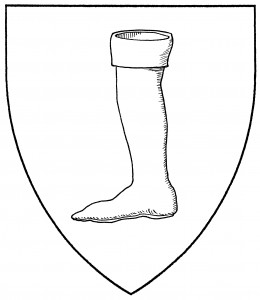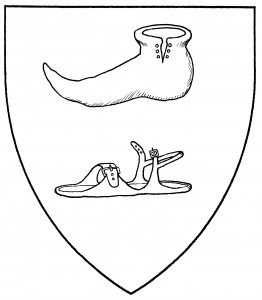A shoe is an item of clothing covering the human foot, to protect it or keep it warm. The generic shoe has the upper portion end at the ankle; it may be tied or buttoned in place. If without tie or button, it may also be termed a “slipper”, as in the canting arms (from Latin caliga, “footwear”) of di Calegari, mid-15th C. [Triv 121].
Frequently, the specific type of shoe is blazoned, e.g., the “boot”, blazoned as “botys” in the arms of Byllyngedon, c.1460 [RH], where they are drawn as long boots; the “Irish broge”, a pointed-toed shoe found in the arms of Arthure, 1632 [Guillim2 299]; or the “sandal”, open footwear held in place with straps, which as a charge appears to be unique to the Society. All shoes have their toes to dexter by Society default; if blazoned “proper”, they are of brown leather.
Despite Society precedent, boots in late period did have heels; and dexter and sinister boots were distinguished in period, though not in armory. For related charges, see hose, leg, sole.
Elizabeth Ryan of Rosewood bears: Lozengy sable and argent, a boot gules.
Alessandra Beatrice Desiderio bears: Per bend sinister argent and azure, two slippers counterchanged.
Christian de Guerre bears: Argent, three shoes and in chief a pearled coronet azure.


